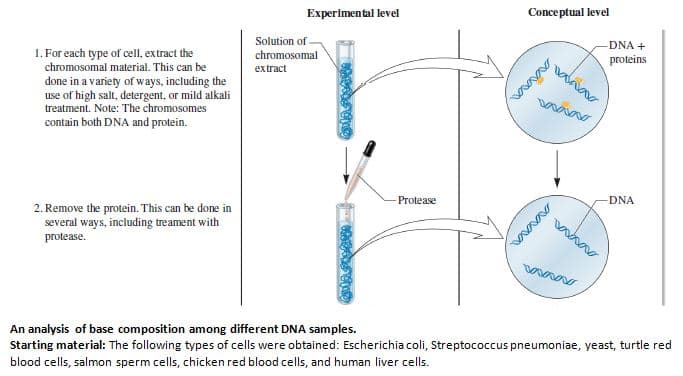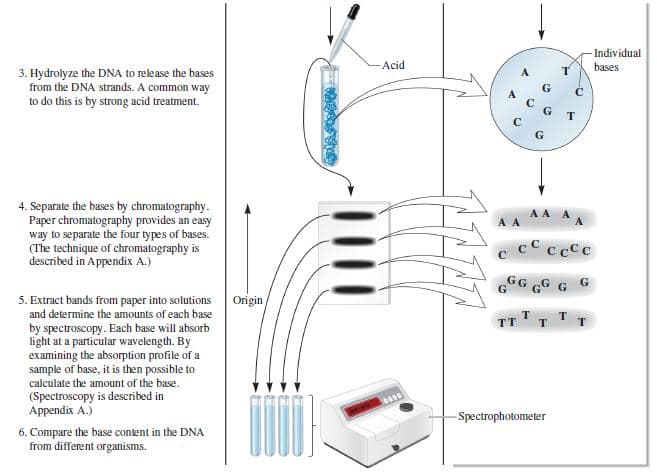Experimental level Conceptual level Solution of DNA + 1. For each type of cell, extract the chromosomal material. This can be done in a variety of ways, including the use of high salt, detergent, or mild alkali treatment. Note: The chromosomes contain both DNA and protein. chromosomal proteins extract - Protease DNA 2. Remove the protein. This can be done in several ways, including treament with protease. An analysis of base composition among different DNA samples. Starting material: The following types of cells were obtained: Escherichia coli, Streptococcus pneumoniae, yeast, turtle red blood cells, salmon sperm cells, chicken red blood cells, and human liver cells. Individual bases Acid 3. Hydrolyze the DNA to release the bases from the DNA strands. A common way to do this is by strong acid treatment. C. 4. Separate the bases by chromatography. Paper chromatography provides an easy way to separate the four types of bases. (The technique of chromatography is described in Appendix A.) AA A cC c cCc GGG GG G G 5. Extract bands from paper into solutions and determine the amounts of each base by spectroscopy. Each base will absorb light at a particular wavelength. By examining the absorption profile of a sample of base, it is then possible to calculate the amount of the base. (Spectroscopy is described in Appendix A.) Origin тт т т т -Spectrophotometer 6. Compare the base content in the DNA from different organisms.
DNA and RNA
Deoxyribonucleic acid (DNA) is usually called the blueprint of life. Deoxyribose is a monosaccharide that has a key function in the synthesis of deoxyribonucleic acid. One less oxygen-containing hydroxyl group occurs in deoxyribose sugar. Nucleic acid, deoxyribonucleic acid, is one of the natural components. Deoxyribonucleic acid is a double-stranded molecule. Watson and Crick postulated the double-stranded model of the helix. A deoxyribonucleic acid is a molecular group that carries and transmits genetic information from parents to offspring. All eukaryotic and prokaryotic cells are involved.
DNA as the Genetic Material
DNA, or deoxyribonucleic acid, is a long polymeric nucleic acid molecule discovered in the late 1930s. It is a polymer; a long chain-like molecule made up of several monomers connected in a sequence. It possesses certain characteristics that qualify it as a genetic component. Certain organisms have different types of nucleic acids as their genetic material - DNA or RNA.
Genetics
The significant branch in science which involves the study of genes, gene variations, and the organism's heredity is known as genetics. It is also used to study the involvement of a gene or set of genes in the health of an individual and how it prevents several diseases in a human being. Thus, genetics also creates an understanding of various medical conditions.
DNA Replication
The mechanism by which deoxyribonucleic acid (DNA) is capable of producing an exact copy of its own is defined as DNA replication. The DNA molecules utilize a semiconservative method for replication.
With regard to Chargaff’s experiment described in Figure shown,
answer the following:
A. What is the purpose of paper chromatography?
B. Explain why it is necessary to remove the bases in order to
determine the base composition of DNA.
C. Would Chargaff’s experiments have been convincing if they
had been done on DNA from only one species? Discuss.


Trending now
This is a popular solution!
Step by step
Solved in 2 steps




